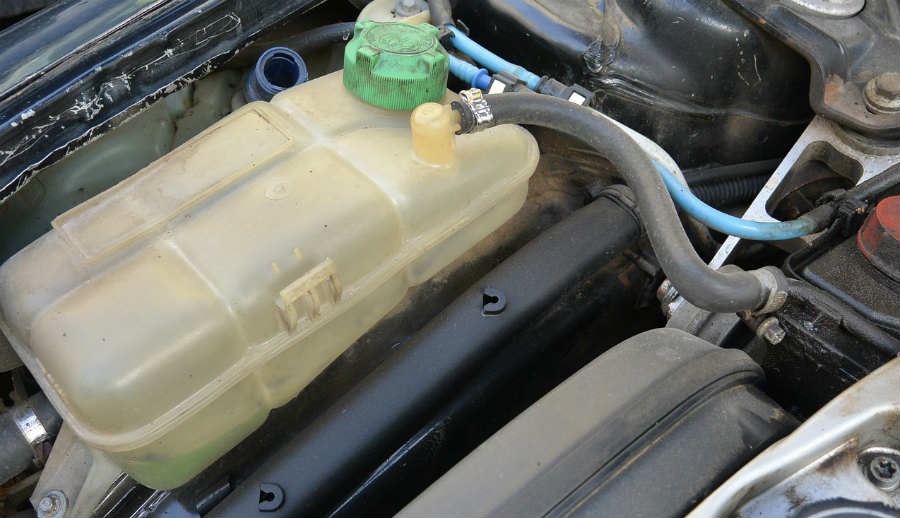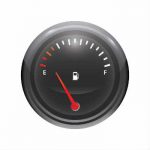One of the characteristics of a cooling system is that it has to operate close to the boiling point of water. The cooling system uses a mixture of water and coolant designed to be resistant to boiling, but the system also operates under pressure to further raise the boiling point.
To maintain the system under a stable operating pressure and to account for expansion and contraction of the fluid, a pressure cap is used. It has one valve that releases coolant to an overflow tank when the pressure gets too high, and it has another valve that opens to allow fluid to be drawn back in.
This happens as the pressure drops when the system temperatures drop. This allows the system to maintain pressure, while also keeping air from the system and maintaining coolant levels.
Costs of Coolant Reservoir Replacement
To determine the replacement costs of the coolant reservoir on some common vehicles, a rate of $100 per hour was used for the labor cost:
For a 2012 Chevrolet Sonic with a 1.4-liter engine, the coolant reservoir is the degas bottle. The labor time to replace the reservoir is estimated at 0.9 of an hour. A factory coolant reservoir costs about $50, and a Dorman part costs about $28. The total cost to complete the job would be about $140 using OE parts, or about $118 using aftermarket parts.
For a 2006 Kia Optima with a 2.4-liter engine, the coolant reservoir is an expansion tank type. The labor time to replace the reservoir is around 0.3 of an hour. A factory coolant reservoir would cost around $29, making the total cost around $59 to complete.
For a 2008 Toyota Camry with a 3.5-liter engine, the coolant reservoir is an expansion tank type. The labor time to replace the reservoir is estimated at 0.3 of an hour. A factory part costs about $76, and a Dorman part costs about $38. A total of $106 would be incurred using OE parts, or about $68 using aftermarket parts.
For a 2006 Ford F-350 with a 6-liter engine, the coolant reservoir is a degas bottle. The labor time to replace the reservoir is one hour. A factory part costs about $159 and an SKP part costs about $30. The total coolant tank replacement cost would be about $259 using OE parts, or about $130 using aftermarket parts.
In most cases, a half-gallon to a gallon of coolant is needed to refill the system after the coolant reservoir, at an additional cost. Most coolants are vehicle-specific and the costs range from about $10 to $25 a gallon.
Coolant Reservoir Replacement
There are a few different names for the coolant reservoir. They can be called an expansion tank, an overflow bottle, or a degas bottle. There are some differences in practice.
An overflow bottle is an older design that doesn’t have a siphon tube to replace coolant into the system, while an expansion tank does.
On the other hand, a degas bottle stands for de-gas, which, unlike the other types, is a sealed part of the cooling system and sits at a high point. It can then more effectively serve as both a reservoir and remove the air from the system.
Most coolant reservoirs are made from plastic, and so, are subject to cracking from age or physical damage. Overflow and expansion tanks are usually lightweight, one-piece plastic units.
Degas bottles are usually heavily constructed to hold pressure and are made in two pieces that are sealed together. Their main failure would from the seam where the two parts are joined.
Replacement is usually fairly easy. Overflow and expansion tanks are almost always located close to the radiator with simple attachments, and one small hose running the radiator fill neck.
A degas bottle is usually located at a higher point near a strut tower or above the engine, and will usually have at least two coolant hose connections. Sometimes, it is necessary to partially drain the cooling system to replace a coolant reservoir of the degas type.

Other Concerns During Coolant Reservoir Replacement
Generally, there isn’t too much else to worry about other than properly topping off a cooling system. For a coolant reservoir of the overflow or expansion tank variety, the only things that need to work well are the radiator pressure cap and the hose from the radiator neck to the reservoir.
These are both inexpensive and easy to replace. The radiator cap isn’t easy to diagnose. There are devices to test the main valve in the cap that holds system pressure, but the second valve that holds the vacuum isn’t normally tested.
In any case, if a problem with the pressure cap is suspected, it’s usually much cheaper to replace it than spend time diagnosing it.
On a degas bottle system, the reservoir is integrated into the cooling system, so there are more possible issues. The hoses that go to it and the clamps that secure the hoses need to hold pressure, and so, need to be in good condition.
If a degas bottle has ruptured at a seam (which is the most common failure of this type of reservoir), there is a possibility that the cause is an over-pressure condition of the cooling system. A few things can cause this.
The pressure cap in this type of system is on the degas bottle itself, so a failure of that should be ruled out. A new degas bottle usually comes with a new pressure cap.
A problem with the coolant condition is also a possibility if it has a boiling point lower than the engine operating temperature. If a sealed coolant system boils, that can increase the system pressure rapidly and put a lot of stress on the components.
Even a properly operating pressure cap has difficulty managing a rapid pressure increase. A head gasket fault can also increase system pressure rapidly, but usually, that will be accompanied by other more serious symptoms.

